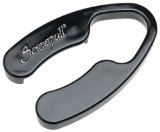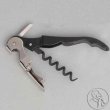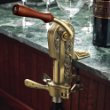How to Open a Wine Bottle
Opening a bottle of wine would seem simple enough, until you try to do it. There are really two basic steps to opening a bottle of wine:
  |
- Removing the lead/foil/plastic cap from the top of the wine bottle - Most wine bottles have a protective covering over the cork and the top of the wine bottle. These coverings are typically made of lead, foil, or plastic. In order to get at the cork to remove it, one must first remove the protective cover. This can be done with a knife (many corkscrews have a small knife built into the handle for this purpose) or a foil cutter (see image).
- Removing the Cork - Removing the cork from the bottle of wine requires the use of a corkscrew. There are many different types of corkscrews, many of which some people have trouble using - this is especially true of the classic waiter's corkscrew (see More on Corkscrews below). Some experimentation may be necessary before you decide upon a the corkscrew that is right for you. The "right" corkscrew should be comfortable and easy to use without breaking the cork.
More on Corkscrews
At its most basic, a corkscrew has a metal helix (the sharp curly part that gets inserted into the cork) that is often referred to as a worm, and a handle that is used for screwing the worm into the cork and pulling it out.
There are many variations on this basic theme and many different types of corkscrews that one may use to open a bottle of wine. The best one is the one that you find easy to use. Following is a discussion of some of the more popular or common corkscrews:
 |
The Classic Waiter's Corkscrew
The classic waiter's corkscrew has a worm, a handle, and a lever that rests on the lip of the wine bottle. The worm is twisted into the cork ant the lever is used to torque the cork out of the bottle of wine. It is this torquing action that makes it difficult for many to use. It can be easy, if one is not careful, to split the cork in half while trying to torque it out of the bottle. Some practice may be necessary to get over this hurdle, and even an expert may break an occasional brittle cork.
Some waiter's corkscrews may also have a knife for cutting the lead/foil cap on the wine bottle. Others have a hinged lever where you can use a shorter lever to get the cork started, and a longer lever to pull it the rest of the way out of the bottle.
The advantage of this type of corkscrew is its small size. It easily fits into a pocket. It disadvantages are that it is relatively difficult to use without some practice, and levering the cork out from one side increases the risk of splitting corks.
 |
The Lever Pull Corkscrew
As its name would imply, a lever style corkscrew uses a lever to drive the worm into the cork and remove the cork. A downward motion on the handle or lever drives the worm into the cork, and an upward motion removes the cork. There are two styles of lever corkscrews: handheld and mounted (usually to a counter top or a stand).
The advantage of this type of corkscrew is that it is relatively easy to use. The disadvantages are price, they are typically more expensive; and size, making them harder to store.
 Screwpull Pocket Model Corkscrew |
The Screwpull
The screwpull is a relatively simple corkscrew. The frame of the screwpull rests on top of the wine bottle. The worm part goes down through the frame on the top of the bottle and is screwed into the cork. The act of screwing in the worm pulls the cork out of the bottle.
The screwpull has many advantages. It is relatively easy to use and almost never splits the cork. It is also relatively inexpensive. The only disadvantage is that the worm may penetrate all the way through smaller corks before extracting them possibly leaving a bit of cork residue in the wine.
 Twin Prong Corkscrew |
The Twin Prong Corks Remover
The twin prong cork remover relies on two parallel slender curve prongs that get slipped down between the neck of the wine bottle and the cork through a gentle rocking motion. The cork remover is then twisted and pulled to remove the cork from the bottle. Getting the prongs down along the side of the cork takes a bit of practice, and for this reason it is one of the more difficult cork removers to use.
Its main advantage for those who persevere and learn how to use it is that breaking corks is a very rare occurrence. One of its main disadvantages, in addition to being difficult to use, is that you are more likely to push a cork into a bottle of wine when you are trying to push the prongs in alongside the cork.
 Two Lever Corkscrew |
The Wing, Butterfly, Two-Lever, or Angel Corkscrew
The winged corkscrew derives its many names from the two levers on the side. Similar to the screwpull, a winged corkscrew's frame is rested on the top of a wine bottle and the worm is screwed into the cork. As the worm drives into the cork the two levers on the side raise up. After putting the worm a sufficient distance into the cork, the two levers are pushed down pulling the cork up and out of the bottle of wine.
This corkscrew is also relatively easy to use, rarely breaks a cork, and inexpensive. It's main disadvantage is the the worm may penetrate all the way through short corks putting a little cork residue into the wine.
So Which is Best?
It really boils down to personal preference. The one that you find the easiest and most comfortable to use is the one for you. You may, however, have to do a little experimenting with several types before you settle on "your" corkscrew.

